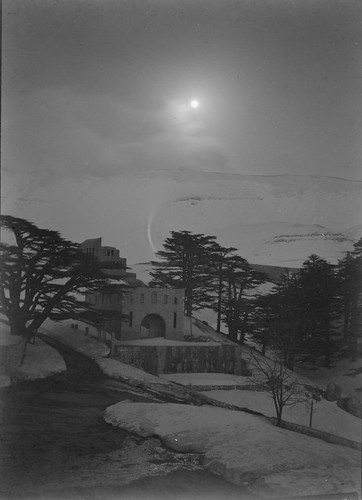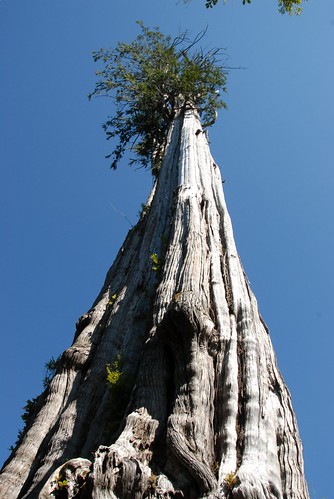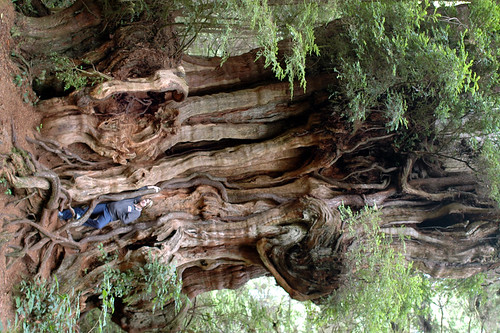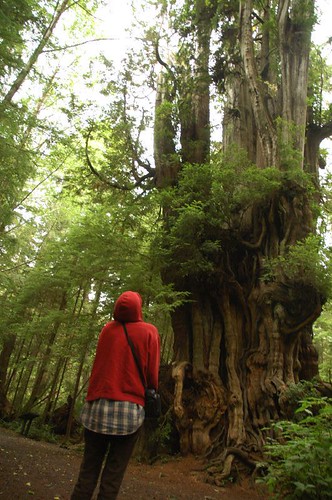This 800 year old tree is a popular attraction in the small town of Tofino on the west side of Vancouver Island. Local residents and arborists have rigged a series of cables and supports to keep the tree standing. I´ve been unable to determine if this tree is a Western Red Cedar or a Port Orford Cedar.
The Eik Cedar.
Jomon Sugi tree - Largest Cedar in Japan
This large “Yakusugi Cedar” (Cryptomeria japonica) tree was located in 1996 and has since become quite famous. It is said to be the largest Cedar tree in Japan. It is 25 meters tall and estimated to be around 2,200 years old (some claim that it is much older). It is called “Jomon-sugi” (meaning Old Cedar) and is located in the Yakushima World Heritage Area.

Roots II, originally uploaded by antonioperezrio.es.
“In its vicinity, there remains a stump of which age is said to be oldest
by the islanders. They say the tree was cut in 1586 to be used for
construction of a big temple in Kyoto. The age of the tree when cut down
is estimated to be 3000 years.” from www.nyu.edu
The Cedars of Lebanon
This large Lebanese cedar tree stands on Mount Lebanon and is a fine example of the tree that is the symbol and pride of the country. This tree species (Cedrus Libani) should not be confused however with what are commonly called “Cedar” trees in the United States. The Cedars of Lebanon have been trees of renown for thousands of years. The wood of this tree was used by Solomon in the construction of the temple that he built in Jerusalem.
The picture below was taken in Lebanon in 1946
 Believed to be in Public Domain From Library of Congress, Prints and Photographs Collections.
Believed to be in Public Domain From Library of Congress, Prints and Photographs Collections.More on copyright: What does "no known restrictions" mean?
The Duncan Cedar
"In 1938 the Federal Government in Washington DC agreed, after a long bettering from conservationists, to carve out a national park 3000 miles away on the west side of the Olympic Peninsula in Washington State. This saved from the loggers four rain-swept river valleys, rich in old growth forests - the Bogachiel, the Hoh, the Queets, and the Quninalt. But, as so often happened in the Pacific north-west, on both sides of the Canadian-US border, the boundaries of the new park were deliberately designed to exclude much of the best old-growth forests.
The Nolan Creek cedar grew in the heart of an ancient forest west of the park. less than 30 years ago, loggers were licensed by the state to clear-fell the whole area. When the chainsaw reached this western read cedar (Thuja plicata) and people realized that it was the third largest red cedar in the world (it's 178 feet tall with a volume of 15,300 cubic feet) even the loggers' spirits failed. Generously they agreed to preserve this single tree - worth, they say, the huge sum of $25,000.
And there is stands today. If the loggers hoped the tree would show their hearts were in the right place, they knew little about trees. Of course the giant could not survive the fierce winds of the clearcut. First the mosses and lichens, then the tree itself, began to die. Now it is a bleached skeleton with few living branches. There is a message there, I am sure, that the public can not miss. How futile is it to make this mean sort of compromise, rather than saving the whole watershed . . . Imagine trying to preserve this king of the forest, when all his kingdom lies in ruin. Soon his bones, too, will lie at Nolan Creek."
-Thomas Pakenham
"Remarkable Trees of the World"
Large Old Cedar at Kalaloch, Washington
This very large gnarly, old Western Red Cedar is located near kalaloch, Washington in the Olympic National Forest. The tree is impresive both for its great size and for the "Ent" like look of its twisted and gnarled trunk.
This tree is known as the Kalaloch Cedar.
another view of this tree
The Kalaloch Cedar, just off Highway 101 in the Olympic National Park
A sign at this tree reads…
Big Cedar
“Western redcedar has been the art and sinew of coastal Indian village life. The trunk is house plank and ocean-going canoe; branches are harpoon line; outer bark is diaper and bandage; inner bark is basket, clothing and mattress. Tree size expresses climate – heavy annual rainfall, and the nourishing damp of ocean fog. In a scramble for growing space other tree species are using the cedar as a standing nurselog.”
another view
Hollow Tree in Stanley Park - Vancouver, BC
A sign by this tree reads…
“This now hollowed out stump with “nurse trees” growing from the crevices of its woody skeleton was once a thriving cedar tree. At one time its girth measured 18.3 meters (60 feet). In the early 1900´s this site was a very popular location for photographs either with horses & buggies backed into the hollow or those newfangled contraptions, automobiles!”
below is an old photograph of this same tree taken in 1897 by William Notman

Great Cedar Tree, originally uploaded by SqueakyMarmot.
**UPDATE - April 17, 2008**
I was able to visit this tree in March. The old hollow tree was damaged in a storm this last December and is hardly standing. It has a few cables keeping it from tipping over. The base has also deteriorated considerably making the hollowed out portion quite a bit smaller than in used to be. As of April 1st the Vancouver city council has voted to remove the old stump entirely. This tree has been in Stanley Park for about 1000 years.

Tree that General Grant planted in Tokyo
Sign at the base of this tree reads...
KANJI KANJI KANJI
"General Grant the eighteenth president of the United States planted this Himalayan cedar when he visited Zojoji temple as a national guest in 1879."
tree species - Cedrus deodora
Labels: cedar, historical, Japan











